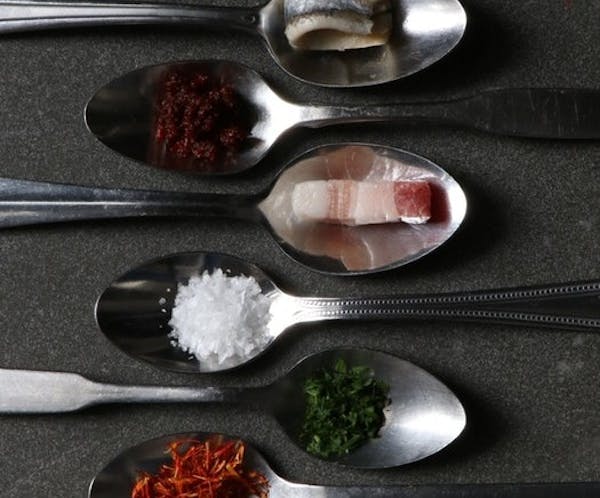Orecchiette With Rapini and Sausage
Serves 4.
Note: This classic dish is from the Puglia region of Italy. From Steve Hoffman.
•2 bunches rapini (also called broccoli rabe)
• 5 tsp. salt, or more, divided
• 1 lb. orecchiette pasta
• 1 lb. hot Italian sausage
• 1/4 c. olive oil, plus more for drizzling
• 6 anchovy fillets
• 7 to 8 garlic cloves, finely sliced
• 1 tsp. crushed hot red pepper flakes
• 1/2 c. low-salt chicken broth, heated
•1 c. freshly grated Pecorino Romano cheese, divided
• 2 tsp. freshly ground black pepper
Directions
Cut off the tough ends of the rapini stalks. Clean under running water in a colander.
Bring a large pot of water to a boil, add 1 teaspoon salt and add the rapini and cook, covered, for 3 to 5 minutes, until the stems are soft; drain and add immediately to ice water. Squeeze out the excess water, place the rapini on a cutting board, and chop into 1/2-inch pieces. Set aside.
Heat a nonstick 12-inch skillet over medium heat. Place sausage in the skillet, break up and crumble with a flat wooden spoon, and cook until it just loses its pinkness; don't overcook. Set sausage aside with drippings.
Bring a large pot of water to a boil and add 3 teaspoons salt. Add orecchiette and boil according to package instructions for al dente. (Stir often because orecchiette tend to stick to each other.)
Meanwhile, in a Dutch oven over medium heat, add the olive oil and anchovies, breaking them up with a wooden spoon to dissolve. Add the finely sliced garlic, 1 teaspoon salt and hot pepper flakes, and sauté until garlic releases its scent and softens slightly but does not turn color, 1 or 2 minutes.
Add the chopped rapini, along with the sausage and drippings, and mix well. Add the 1/2 cup hot chicken broth to the sausage and rapini mixture, stir and keep warm on low heat until pasta is ready.
When pasta is cooked, ladle out about 1 1/2 cups pasta water and set aside.
Drain pasta in a colander and add to the rapini mixture. Stir well, and begin adding the reserved pasta water 1/2 cup at a time. Once the water is no longer being absorbed, and you see liquid at the bottom of the pot, you've added enough pasta water.
Remove pot from heat and sprinkle 1/4 cup cheese evenly over pasta. Add the freshly ground black pepper and stir well. Taste and adjust for salt, if needed. Serve in bowls immediately, and drizzle with olive oil. Top with remaining cheese. The consistency of the dish should be slightly creamy from the pasta water.
Nutrition information per serving:
Calories1,100Fat51 gSodium2,540 mg Carbohydrates108 gSaturated fat16 gTotal sugars5 g
Protein49 gCholesterol80 mgDietary fiber9 g
Exchanges per serving: 1 vegetable, 6 starch, 1 carb, 4 high-fat protein, 2 ½ fat.
Frisée Salad
Serves 4.
Note: From Steve Hoffman.
• 1/2 lb. frisée (curly endive)
• 8 oz. cured, thick cut pork belly or pancetta (not smoked)
• 1/2 garlic clove, crushed or minced
• Large pinch coarse salt or fleur de sel
• 1 tbsp. good red wine vinegar or Banyuls vinegar
• 1/4 tsp. Dijon mustard
• 3 tbsp. olive oil, divided
• 4 sprigs fresh parsley, minced
• Poached or soft-boiled egg, optional
• Maldon sea salt or fleur de sel, divided
Directions
Wash frisée, tear into bite-sized pieces, and distribute in a large bowl.
Slice pork belly or pancetta into 1/4-inch slabs (if not already thick-cut into slices), and then crosswise into 1/4-inch batons or lardons. Dimensions should be about 1/4 inch by 1/4 inch by 2 inches.
Sauté lardons in a nonstick or cast iron skillet over medium heat until golden brown but not crispy. They should still have some give.
For the vinaigrette, place garlic in a bowl with large pinch of salt and 1 tablespoon vinegar. Let sit for 5 minutes. Add mustard and whisk to a smooth consistency. Continue whisking and slowly drizzle 2 tablespoons olive oil into bowl. Taste. If still quite tart, slowly add the remaining 1 tablespoon olive oil, a small amount at a time, until vinaigrette is slightly thickened and taste is pleasantly tart but not oily.
Add vinaigrette slowly to the frisée, about 1 tablespoon at a time, mixing it into the leaves by hand until they are just coated with a light sheen. There should be no pooled vinaigrette at the bottom of the bowl.
Add lardons and toss gently. Distribute the salad into individual bowls. Sprinkle parsley over the salad.
The salad can be eaten as is, although a classic variation, called Salade Lyonnaise, calls for a poached egg (or, as a second choice, a soft-boiled egg) to be set on top of the salad before serving. Add a tiny sprinkle of finishing salt, Maldon or fleur de sel, onto the egg.
Nutrition information per serving:
Calories175Fat16 gSodium350 mgCarbohydrates2 gSaturated fat3 gTotal sugars0 g
Protein6 gCholesterol15 mgDietary fiber2 g
Exchanges per serving: 1 high-fat protein, 1 ½ fat.

6 Minnesota breweries win medals at 2024 World Beer Cup
Seattle Kraken move games to over-the-air broadcaster with streaming on Amazon's Prime Video

An infamous heist put this North Woods town in the global spotlight. Nervous breakdowns and Hollywood deals ensued.

